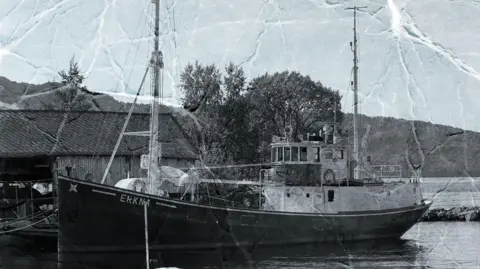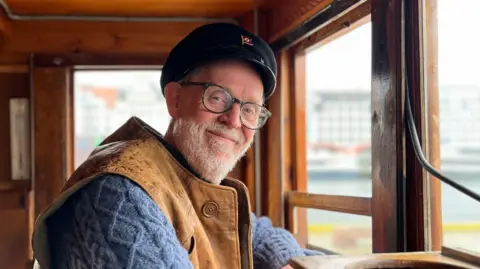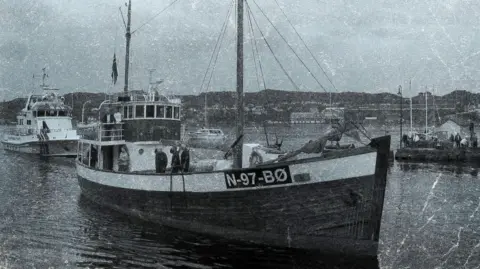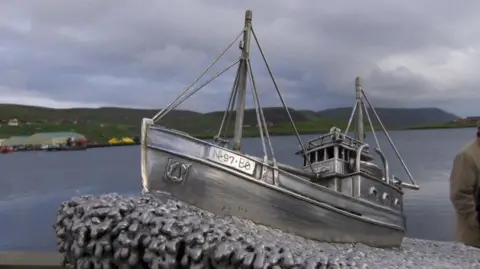How the 'Shetland Bus' helped Norway resist Nazi Germany
 The Scalloway Museum
The Scalloway MuseumIt sounds like it could be the plot of a spy novel, but the "Shetland Bus" was a real undercover operation carried out to help the resistance in Nazi-occupied Norway during World War Two.
In the depths of winter and under the cover of darkness, convoys of small fishing boats left the safety of Scotland's most northerly islands to deliver valuable cargo and special agents to coves and fishing ports 200 miles away along the coast of Norway.
On the perilous return journeys, refugees fleeing the occupation were hidden in the hold of the fishing boats, as they sought sanctuary in the British Isles.
To commemorate the 80th Anniversary of Victory in Europe (VE) Day, six of the historic ships that formed part of the Shetland Bus convoys set sail again from Bergen in Norway, replicating the journey back to Shetland.
The Liberation Convoy arrived in Lerwick on Tuesday in time for the VE Day commemorations, and will also visit Aberdeen and Edinburgh.
 The Liberation Convoy
The Liberation ConvoyNorway was invaded by Nazi Germany on 9 April 1940, a few months before the full occupation of France.
The Norwegian government and its Royal Family, including King Haakon VII, were forced into exile in London and thousands of Norwegian people followed in fishing boats and other small vessels, crossing the North Sea to seek refuge in the UK.
In July 1940, British Prime Minister Winston Churchill set up a clandestine organisation called the Special Operations Executive (SOE) with the sole aim of carrying out espionage and sabotage missions across German-occupied Europe.
The Shetland Bus convoys were part of the Norwegian branch of the SOE, supporting the resistance movement in Norway.
Between 1940 and 1945, they made 200 North Sea crossings, transporting hundreds of resistance agents, tonnes of weapons and supplies, and rescuing more than 300 Norwegian refugees fleeing the occupation.
 The Liberation Convoy
The Liberation ConvoyThe 200-mile crossings took place in winter to make the most of the hours of darkness and avoid being spotted by German patrols.
But this meant that the sea was often treacherous.
The crews and passengers on board had to endure not only heavy North Sea conditions, but also the constant risk of discovery by German aircraft or patrol boats.
 The Liberation Convoy
The Liberation ConvoyOn 27 September 1941, the MK Arnefjord left the small island of Hernar, to the north-west of Bergen, carrying 20 refugees.
Although the weather started off calm, they soon encountered a raging storm. Everyone onboard was seasick and some discussed turning back.
Eventually the Arnefjord made it safely across and delivered crews and passengers to the island of Mousa in Shetland.
But others were not so lucky. Of the six boats that crossed the North Sea with the Arnefjord that weekend, only four made it.
In total, 10 fishing boats were lost during the Shetland Bus convoys and 44 men lost their lives.

The current skipper of the MK Arnefjord, Morten Neset, is making the return journey back to Shetland as part of the VE Day commemorations.
He told BBC Scotland News that the boats had to make the crossings in the winter or late autumn to avoid being detected by the Germans.
"If they crossed on a clear summer day, they would be spotted straight away," he said.
"The Shetland Bus was really important for the general population of Norway as it showed that someone was 'standing up for them' in their resistance against the occupation."
 The Liberation Convoy
The Liberation Convoy
Bill Moore, from the Shetland Bus Friendship Society, said that, although it was difficult to say what impact it had on the war, it was an important part of the resistance movement which gave optimism and hope to the people in Norway.
People said they were "taking the Shetland Bus" as a code for escaping the occupation.
Shetland residents hosted soldiers and refugees from Norway throughout the war, forming a close bond between the two locations that endures to this day.
